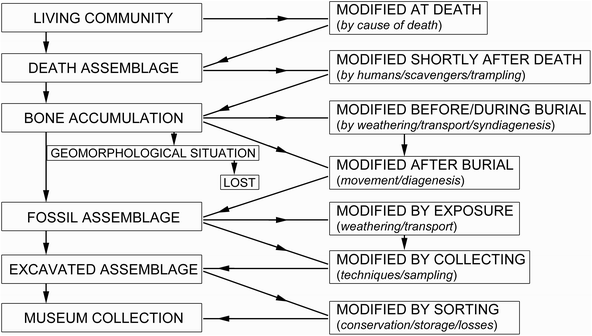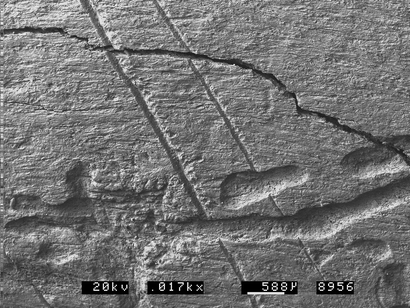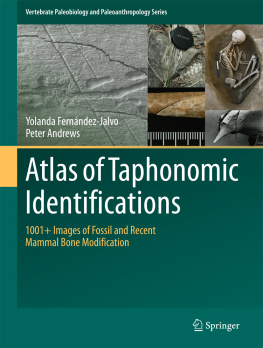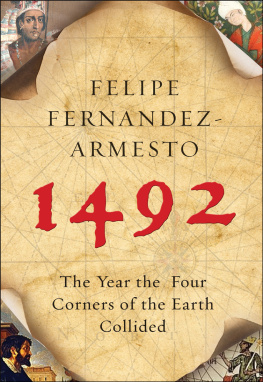1. Introduction and Rationale
Most simply put, taphonomy is the study of processes affecting the transition of the remains of past living organisms and their traces into the lithosphere as seen in the prehistoric record. It has many aspects, from processes affecting individual organisms to those affecting whole communities, but at its most basic level, the processes on which taphonomic interpretations are based are the same. Process is thus defined as the action of a taphonomic agent (Lyman 1994a), the agent being the immediate cause of modifications. The evidence by which process is identified in the fossil record is the effect it has on fossils, the biological, chemical and physical modifications preserved on the fossils. These modifications may be identified and interpreted through comparisons with observed processes produced by known agents acting on previously unmodified bones at the present time, either in experimentally controlled conditions or by naturalistic monitoring projects where agents and processes are known.
The taphonomic history of single specimens or of animal or plant fossil assemblages starts when living organisms die and are modified by decay, exposure, burial and later diagenetic effects. It is the sum of the effects (modifications) observed on the remains of the organisms that is the basis for interpreting the processes affecting the assemblages (Fig. ). Similarly, groups of organisms individually pass through the same stages and are affected by the same or different processes, and it is the sum of these, the evidence of the variety of processes, that is the basis for the taphonomic history of the group. Whether working at the individual level or on biotic assemblages, therefore, the evidence needed to reconstruct taphonomic history begins at the level of the modifications observed on individual bones or skeletons, and these are combined to obtain general information about the fossil association.
Fig. 1.1
Stages in the formation and modification of animal assemblages. The four stages are shown on the left, from living animals to fossil assemblage, and the modifications possible at each stage are on the right. The arrows indicate alternative pathways connecting both the stages themselves and the processes between stages
Taphonomy provides evidence additional to taxonomic identification. Too often taphonomy is viewed as an unnecessary complication in the analysis of fossil assemblages, for example in the reconstruction of paleoecology, but it enhances the information content of fossils. Because modifications recorded on fossil bones are the response to organic or inorganic agents that may not fossilize, taphonomic modifications should be seen as additional information about these processes acting in the past rather than just as destructive processes (Fernndez-Lpez 1991). Figure is a scanning electron micrograph of the proximal end of the shaft of a human femur from Coldrum, Kent (UK), and it shows several stages in the taphonomic history of this bone: first of all, two cuts marks were made by a left-handed person, and the cuts run diagonally across the shaft close to the junction with the head of the femur. The position of the cut marks relative to muscle insertions indicates that the object was to cut through the muscle at the top of the leg, perhaps so as to disarticulate the leg. Secondly, the femur shows no evidence of any weathering on the surface of the bone suggesting the bone was protected from direct sun exposure and changes in temperature and humidity, and this indicates that it was buried soon after disarticulation. Thirdly, the bone was buried in a biologically active soil and at shallow depth since there are root marks superimposed on the cut marks, and the root marks were probably made by woody herbs or bushes. The final event in the taphonomic history of this bone was that the bone was cracked and slightly displaced by soil pressure, displacing the line of both the cut marks and the root marks. This sequence of events, which is the taphonomic history of the bone, enhances the value of this specimen because it expands our knowledge of the past.
Fig. 1.2
Scanning electron micrograph of the proximal end of the shaft of a human femur from Coldrum, Kent (UK). The sequence of modifications on a fossilized bone is shown here. First to occur were slicing marks resulting from disarticulation; these are interrupted by root marks, which were made later and which indicate plant growth on the site after burial of the bone; and finally the bone has cracking superimposed on both cuts and root marks as a result of sediment compaction
Building on the modifications and processes observed on the individual fossils preserved in a fossil assemblage, we may reconstruct the extent to which a prehistoric bone assemblage has been altered, for example by its mode of accumulation, the time taken for it to accumulate, and fossilization and/or diagenetic processes. The first might entail transport from one place to another or the intervention of predators, the second entails time averaging, the length of time it takes for an assemblage to accumulate and be buried and preserved, and the third depends on the sedimentary environment present at the place of preservation. All of these processes leave traces on the bones, and the correct identification of taphonomic processes depends on accurate description of the modifications resulting from these processes. There is much more that can be done, however, and in undertaking this compilation we have shown some of the strengths and weaknesses of the current state of taphonomic research. For example, we cannot at present reliably link tooth marks to the predators that made them, and often it is not possible to distinguish between predation and scavenging. Multiple modifications may further confuse the issue, such as the evidence left by bacterial attack on digested bones. These and other issues will no doubt be the subject for future research for many years, and as our comparative database increases and becomes more sophisticated it will be possible to produce a more complete and accurate set of images.
We have produced a collection of images with the aim of providing images of taphonomic modifications on vertebrate bone, both recent and fossil. As stated earlier, the images we use, the photographs, SEM microphotographs and drawings, are largely drawn from our own work spanning the past three decades. We have investigated a range of sites from the Miocene to Holocene, but the majority of images come from the Pleistocene, from both cave deposits and open land surfaces. Our work has mainly been concentrated in Africa and Europe, and so again most images are from these two regions. This work, therefore, is a compilation of our ongoing research, some published and some not, and over the years it will be added to as additional work is done. We have restricted our use of work from other sources to subjects missing from our own work, and we are grateful to our colleagues who have given permission to use their images. We have made the work as comprehensive as possible with the evidence available, providing images of a wide range of modifications both from natural and experimental situations and from the fossil record. Unfortunately there are still many modifications that have not been studied fully, together with the agents that produce them and the processes by which they are formed, and some have not been studied at all. Therefore some images that we include have no positive identification as to agent. Images drawn from published work, both our own and from other authors, are all referenced in the main part of the book, and where there is no reference the images are from our unpublished taphonomy collections at the Natural History Museum, London, Blandford Museum, Blandford, or at the Museo Nacional de Ciencias Naturales, Madrid.












